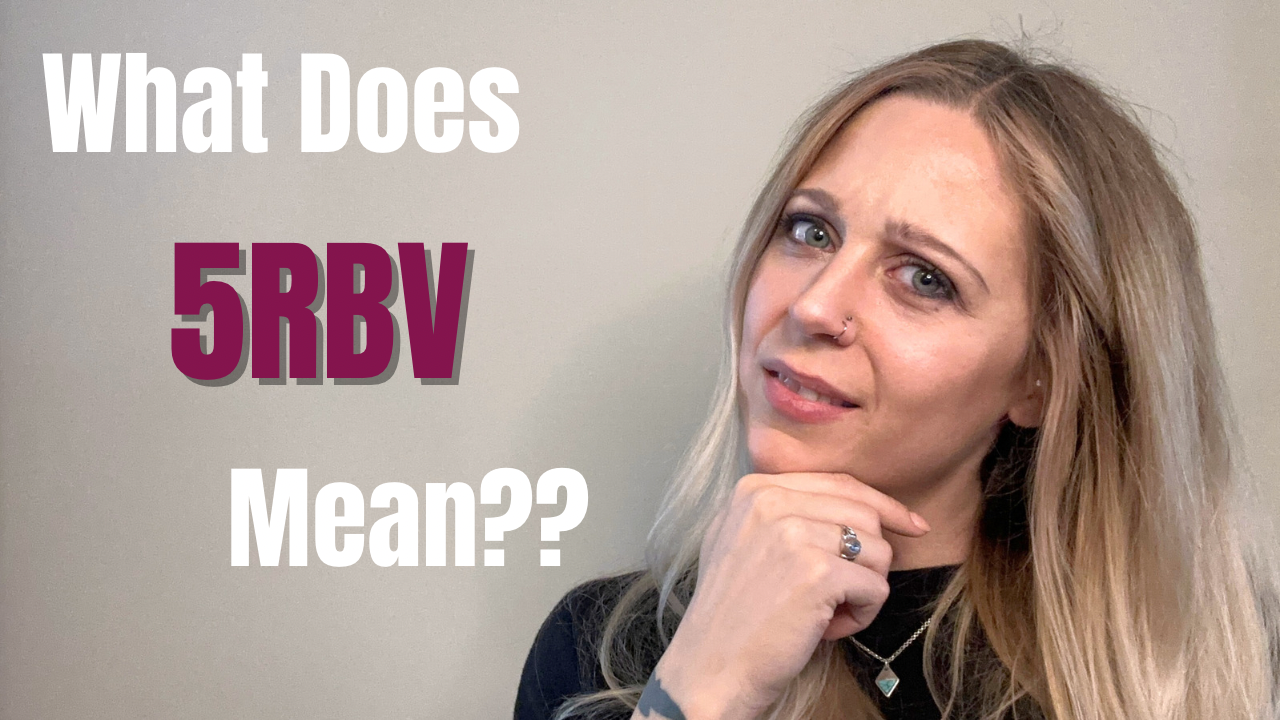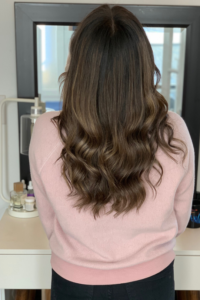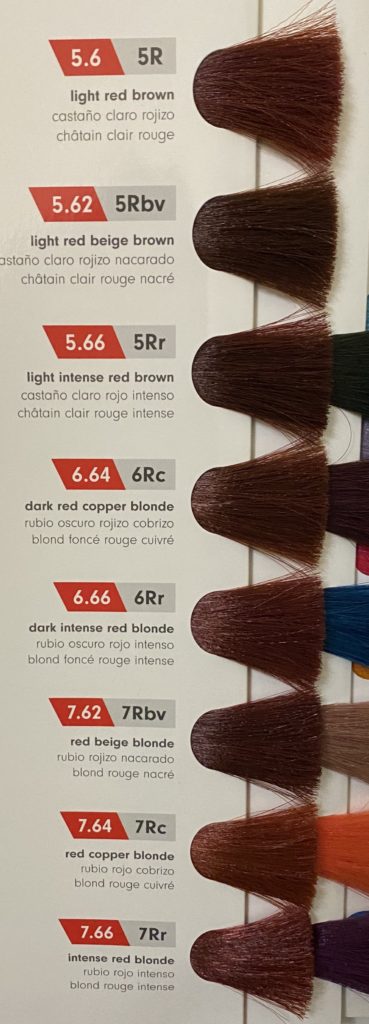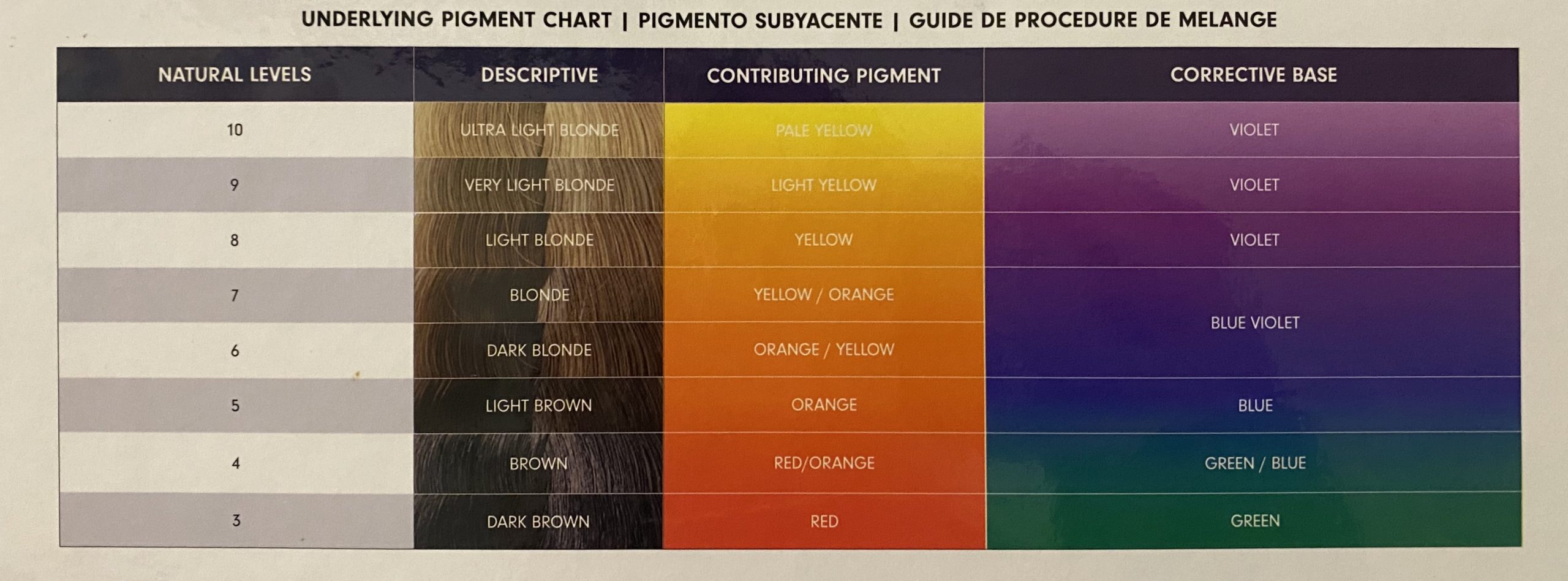
Understanding The Level System In Hair Color
Do you ever wonder what the numbers mean on a hair color tube? Maybe you’ve heard your hairstylist ramble off what sounds like a foreign language when reading your hair color formula. When your stylist refers to numbers, she’s referring to the level system.
You can watch my Youtube video on the level system here:
What does the level system mean?
The level system is a universal system that determines the lightness or darkness of your hair color. These numbers range from 1-10. If you come across a color line with 12’s, that means that that hair color is a hi-lift color. Hi-lift just means that it produces a higher level of lift than traditional hair color does.
Not all brands will translate completely evenly across the board. In one product line you may be a 5, but in another that could translate to a 7! Some lines just run darker or lighter than others. So it’s very important to trust your hair stylist if she is using a number on you that may sound too light or dark compared to what another stylist may have used.

What are the numbers in the hair color level system?
In the level system, 1 is black and 10 is the lightest blonde. A good rule of thumb is as follows:
1 – Black
2 – Darkest brown
3 – Dark brown
4 – Brown
5 – Light brown
6 – Darkest blonde
7 – Dark blonde
8 – Blonde
9 – Light blonde
10 – Lightest blonde
The level is always the very first number that you’ll see in a hair color. It is what comes before the letter. Or if the hair color line uses the number system for shades, it is the number before the period, dash, or slash. We’ll talk about the shades and tones below.
What do the letters mean in hair color?
The letters in hair color refer to the tone, or shade of the color. So 5R means level 5, red.
Some color lines do not use letters, they use numbers instead. While at first this can appear confusing, once you learn all the numbers it is very helpful for learning multiple brands color lines. This number system was originally created for lines that want to translate to different languages so that it’s universal and not confusing if the line was originally created in a different language.
In these lines 5R would be 5.6. So the number that comes before the point is the level which is 5 (light brown), and the second number 6 behind the point refers to the tone of the color. 6 equals red.
This being said, not all lines translate completely evenly across the board with the number system. So it’s important to study the color line you’re looking at to be sure you’re using the right color. For the most part, they are on the same page. There are some differences when it comes to tertiary colors (colors mixed with a primary and secondary color).
Hair color number system
Here I’ll list out the number system for Pravana, which is the hair color line that I use most regularly in my salon. Keep in mind that these numbers are separate to the level system, which determines the lightness and darkness of the hair color.
The number system is referring to the shade or tone of the hair only. The number system comes after the period, dash, or slash in the color, while the level is the number before the period, dash, or slash.
1 = Ash (Green Base)
2 = Beige (Blue Violet Base)
3 = Gold (Yellow Base)
4 = Copper (Orange Base)
5 = Mahogany (Red Violet Base)
6 = Red (Red Base)
7 = Violet (Violet Base)
8 = Pearl (Pink Silver Base)
9 = Smoke (Blue Base)
0 = Sheer (No Base [This dilutes a tone, and will take on more of the underlining pigment, some lines use this as their N or Neutral tone])

I’m not going to go super in depth on the tones of the hair in this post, but you can learn more about the tones and the color wheel in this post.
Why is the level system important in hair color?
In hair color, the level system is literally EVERYTHING! Before I do any color service, the first thing I do is check the level of the natural hair color. This tells me what I need to do to get you to your desired level.
The level of your hair color also determines what tone your hair is capable of being. You can’t have platinum silver hair with a level of 3. The hair would have to be lifted to a 10 in order to take on that tone.
You need to take into account for the underlining pigment for the colors that you’re looking at. Next, we’ll dive into the underlining pigment of the hair.
What is underlining pigment in the hair?
Underlining pigment is the color that lies underneath of the level. It is what warmth lies in each level of hair color. So if you take a level 5 and try to lighten it, the hair would first turn orange. This means that the underlining pigment of a level 5 is orange.
The same holds true when darkening a hair color; the orange must be replaced if you wish to become a level 5 brown from a blonde. This process is called “filling” the hair, and I’ll talk more about it below with going down in hair color levels.
Here you’ll find a chart that is on the back of my Pravana color book. This helps to show you what is underneath each level. Don’t pay attention to the corrective base right now, as that is covered in my post on the color wheel.
1-3 – Red
4 – Red/Orange
5 – Orange
6 – Orange/Yellow
7 – Yellow/Orange
8 – Yellow
9 – Light yellow
10 – Pale yellow

Keep in mind that ALL hair contains an underlining pigment. If the hair has been lifted to the point where it’s no longer pale yellow, my guess is that it’s turned to mush and is breaking off. Only so much of the hair can be removed before the cortex is severely damaged.
Going up the hair color level system
Going up in hair color levels means that the hair is being lightened. You could also say that the color is being stripped from the hair, or decolorized. If your hair is virgin, this is doable with permanent hair color, up to a few levels (each line is slightly different).
But hair that has been previously colored cannot be lifted AT ALL with permanent hair color. Bleach (lightener) must be used. (This is why it is EXTREMELY important that you are honest to your stylist about having previous color on your hair). Otherwise you’ll apply the color and it will stay the exact same.
You also cannot get a very high level of lift with permanent hair color, typically 1-3 levels. High-lift hair color is the next step, which will do 3-5, and lightener must be used if you want to lift 5 or more levels and lighten the underlining warmth.
Going down the hair color level system
Going down in hair color levels means that the hair is being darkened. While this may appear to be easy, this is where many problems can arise due to inexperience.
If you want to color your hair a level 3 dark brown from a level 10 platinum blonde, you CANNOT just throw a level 3 brown on the blonde.
The hair would turn a muddy greenish color and it would fade extremely fast to an even more unpleasant color. In order to properly do this, you must first fill the hair.
Filling
Instead of just throwing the level 3 onto the blonde hair, the hair must be filled first with the correct underlining pigment for a level 3. This is basically a toner that is applied to the hair before the level 3 brown is applied. I typically use a filler anytime I am dropping 4 or more levels.
You can also formulate to add the red into the color you’re trying to achieve. You’ll want to add 1/4-3/4 of the fill color into your formula, depending on several factors that we aren’t going to dive into here.
Check the chart above in the underlining pigment section to see what filler formula you would need to use. In this case if you were a level 10 and wanted to go to a level 3, the hair must be filled with red first.
Depending on the desired tone of the level 3, I would apply a level 5-7 red, red-copper, or red-violet on the hair. Once that is applied, processed, and rinsed off, then you can apply your level 3 brown.
Conclusion
The level system refers to the lightness and darkness of a hair color. It ranges from 1 to 10 with 1 being black and 10 being the lightest blonde. The level is always the first number you’ll see in a color.
The tone or shade of the hair color is what comes after the level. It may be shown as a letter, OR a number. For example, 5R or 5.6. While most of these codes are pretty universal, study your color line to be sure you’re using the right color.
You’ll use the level system to determine the underlining pigment in the hair. The underlining pigment is the warmth that is exposed and that lives inside of each level of hair color. You’ll need to be aware of the underlining pigment when formulating your hair color, no matter what direction you’re taking it.
There’s a lot more to hair color than you thought, right?! This is yet another reason why we are required to have a license to do hair. It’s also why you shouldn’t attempt to color it yourself at home unless you really know what you’re doing.
If you have any further questions for me, leave them in the comment section. And be sure to subscribe below if you want to make everyday a good hair day!
Last edited 03/29/2024



Comments